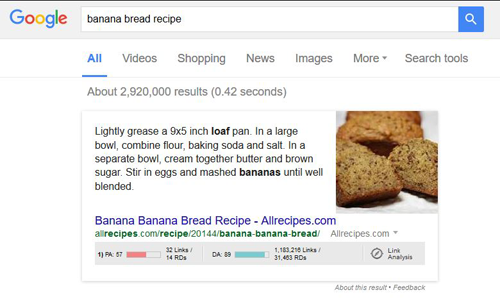Earning Clicks in the Knowledge Graph Era

:: By Travis Bliffen, Stellar SEO ::
Google's algorithm updates are not intended to keep businesses with high-value content down. Instead, these are designed to ensure that Web users continue finding what they need and that they find it as quickly as possible.
Google is constantly working to boost its efficiency even as it compiles and organizes data at a mind-boggling rate. Panda, Pigeon, Penguin and Hummingbird were all launched with two primary goals: to build the world's largest and most impressive knowledge databank and to organize this information for optimal and universal accessibility. Rank brain is the next natural evolution in achieving this goal.
This has been a massive undertaking for this search engine giant and a goal that Google has valued and prioritized since its inception. A push for change, however, can often result in collateral damage. As a business owner, a change from Google can be catastrophic to your business but Google is willing to create that damage in a quest for the betterment of their search engine result pages (SERPs). Fortunately, there are several, simple strategies that can help you start earning clicks in the Knowledge Graph era (read on to understand more of what that is) so that even the efforts to build the world's biggest databank don't slow you down.
Beware of the Dreaded Preview and Use the Literary Cliffhanger to Capture Human Interest
One of the biggest complaints that site owners and marketers have about the most recent version of the algorithm is its tendency to preview the highest quality content in such a way that users never actually need to go to the related Web pages. Looking for an easy recipe for banana bread? Google will post the entire recipe right in its preview, especially if it's short, concise and projected by the algorithm to be best in line with the Web user's query.

In effect, they're cheating people who have done all the hard work of crafting quality content out of the clicks they deserve. This is especially true for sites that only have bite-sized content. Although the preview method works great for the would-be baker that's searching in the kitchen via mobile phone, it does nothing for the recipe-writer who likely has silicone baking utensils or another affiliate product to sell.
The solution?
Always end your bite-size content or content that's likely to get previewed with a cliffhanger. While you still answer the question in the initial search query, you lure readers back to your site by piquing their curiosity on another topic entirely. For instance, the recipe writer can finish each recipe with the hook, "There's only one way keep your loaves from going flat at high altitudes."
In fact, tidbits like these can be peppered throughout the content so that no chance to snag a click is ever missed. Google can give away the content that you've labored to create in a commitment-free preview, but you can still make Web users come to you. Call it a cliffhanger or call it a tease, just know that it works.
Go Beyond Giving The Facts and Jazz Your Content Up With Charts, Graphics And Other High-Interest Additions
Another way to start earning clicks in the Knowledge Graph era is to make sure that your site is always landing on the preview spot when you need it to. Getting to the top of first page results could be your best chance at being seen. But what if you're sharing static data that's been shared by other site owners such as a recent statistic or calculation? How can Google's search bots know that your website has the most user-relevant data? Surprisingly, this one is fairly easy. Simply enhance the value of the information that you've supplied with the addition of charts, graphs and other high-interest additions that enhance the usability of the information that you've supplied. At the end of the day, you're really just working to convince robots that your site deserves to be at the top of the page. If they see that you've answered the query in the greatest number of ways, then you're virtually guaranteed to trump the competition. Of course your page needs to be setup for a great user experience, but you have to get them to the page first.
Preview Your Site like You Would Your Resume
The information you value most should always be at the top of the page. This should also be the very same information that web users are likely to submit queries for. When reviewing your site and touching it up, make sure that it's ordered and organized much like a resume. High-interest information goes up high, you only have a split second to capture their attention, make it count. Order your pages and posts from high-interest content on down to low-interest content that's still worth including. Supplement this strategy with plenty of cliffhangers or teases, people will start clicking through in short order.
Pride Yourself In Originality
Some aspects of the SEO process never change. Unique content always trumps content that can be found in countless other places, assuming you have a good link building strategy in place. Find your voice and use it. Google's massive databank is largely an exercise in the ever-changing science of semantics. Say what people need to hear, but say it in a way that it hasn't been said before. Pay attention to how human users are speaking about your industry and communicate in the way that they're likely to communicate rather than flaunting your industry jargon. Not only will this give your content a more personable feel, but it will also better match your tone to that of search queries.
Like all aspects of optimizing and getting clicks, driving traffic to your site in the Knowledge Graph era is a process that remains in a constant state of flux. What works and what doesn't work is guaranteed to change. The good news is that there will always be ways for industrious marketers to make the latest system work to their advantage.
Over to You...
Has Knowledge Graph influenced your website traffic? Good or bad?
Author Bio
 Travis Bliffen is the founder of Stellar SEO, a Web design and marketing firm located in Marion, IL. Travis and his team are equipped to handle any size SEO project and have helped numerous businesses to date build a rock solid online presence. When you are ready for more leads and sales, it is time to get #stellarized. Connect on Facebook or Twitter @theseoproz
Travis Bliffen is the founder of Stellar SEO, a Web design and marketing firm located in Marion, IL. Travis and his team are equipped to handle any size SEO project and have helped numerous businesses to date build a rock solid online presence. When you are ready for more leads and sales, it is time to get #stellarized. Connect on Facebook or Twitter @theseoproz









